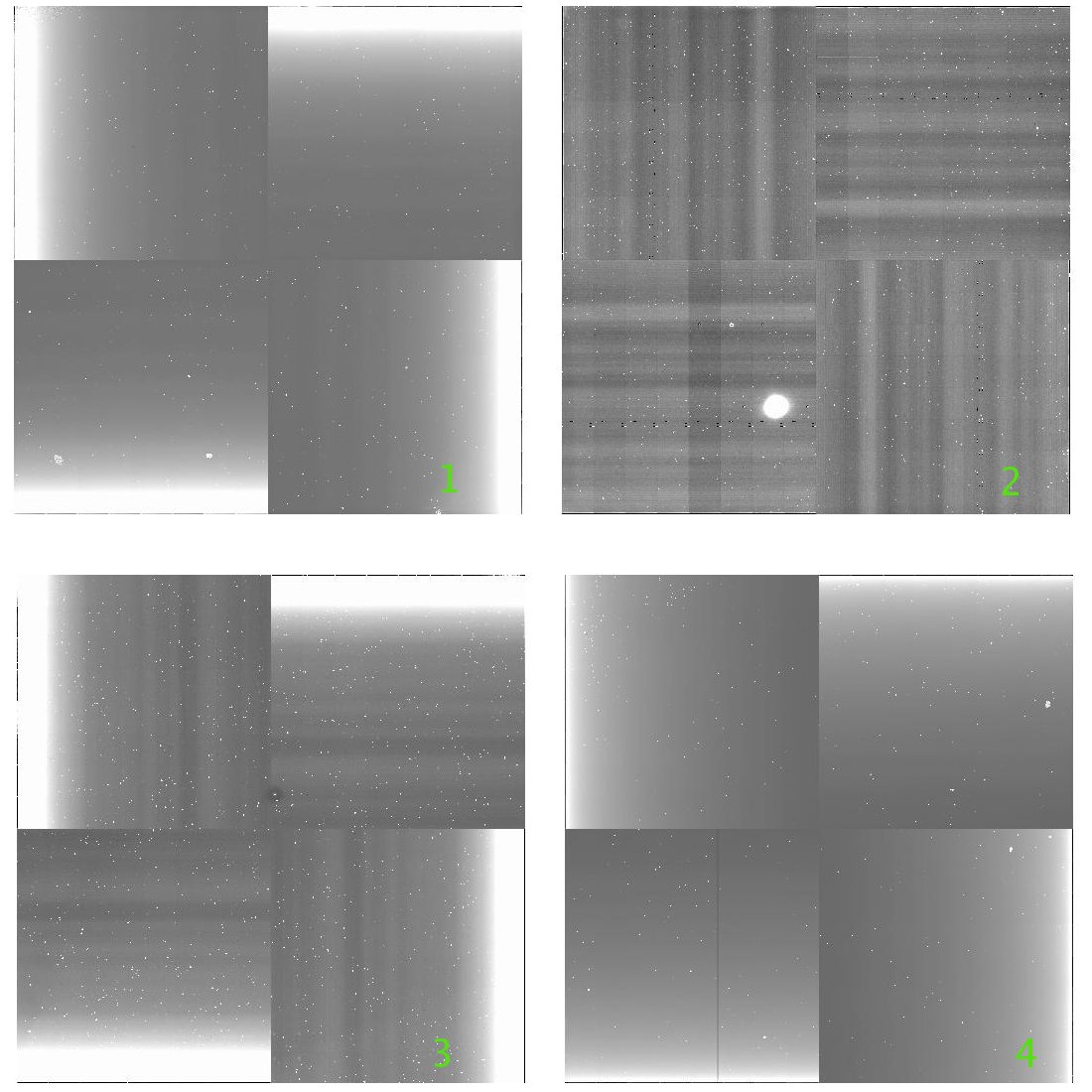
All IR detectors suffer from reset anomaly to some degree or other. This is a report on the current understanding of both the reset anomaly and other 2d additive effects preset on the WFCAM detectors. Most of the data used in this study comes from November 2004. Where necessary I'll get the exact files as this may help with follow up work. It is not my long term intention to work out the causes of any of these effects, just how best to remove them.
Detectors 1,3,4 all have a strong ramp to one edge -- detector 2 does not. Because the dynamic range of each of the darks is very different, it wasn't possible to display them all on the same grayscale and make them look sensible. For reference the median value in a small region ([487:511,27:51]) of each image gives the following result for each detector -- 1: 599, 2: 14, 3: 329, 4: 934.
Also seen in all four detectors, but most obvious in #2 is the low level ripples that appear in each quadrant. These will be discussed later.
The standard practice at UKIRT and other places is to use dark frames to remove reset anomaly from the target images. This usually involves having dark frames taken with the same readout parameters as the object frames of interest (that is exposure time, readout mode and number of coadds). Another standard practice at UKIRT is to take a single dark frame with the relevant exposure parameters just before a series of observation frames and to use this one frame to correct the reset anomaly. This is slightly dangerous as artefacts such as cosmic rays and persistent images from previous exposures may be present on the dark frame. What would be safer would be to use a number of dark exposures with the correct exposure parameters combined with rejection to remove such artefacts. This however depends on whether the form of the reset anomaly is stable of the course of the night.
To answer this we looked at the dark frames from the nights 20041108 and 20041109. (These happened to be convenient nights to use. Other nights showed similar results to what we're reporting here.) We separated all the dark frames taken that night into groups depending upon their exposure parameters. By doing lots of differences of frames to see how well the reset anomaly ramps are removed we have come up with the following results:
Artefact 'a' appears whenever there has been a change in filter. The first images in a filter series are always affected by this. The image below is three dark exposures taken in sequence with the fourth dark exposure of that sequence subtracted off. The feature gets fainter after each exposure indicating that it is some sort of persistence effect.
To prove that this feature really does decay with time and is not an artefact of the exposure parameters, here are two panels of exposures in the Z and Y. Each filter had 5 observations done, all 5 with the same exposure parameters. Subtracting the fifth observation from the first four gives the results below. Both sets show the feature quite strongly in the first frame, weakly in the second and all but gone in the third.
Artefact 'b' appears as either a bright or dark splodge and only seems to appear when you difference two frames with differing exposure times as in that dark panel. In the Z and Y panels above, it isn't visible at all. This is probably some sort of 'hot spot' that emits in a reasonably time dependent way as it is removed well by another observation of the same exposure time. The fact that it appears as a negative splodge in the dark panel above confirms this as the subtraction for these images was done in the sense of short exposure minus long exposure time.
Although the feature does vary with exposure time, it doesn't vary linearly. The graph below show the best fit to the measured flux of the feature versus time. The best fit is a cubic with an implied non-linearity of about 2.1%.
The panel below shows four attempts to correct for the feature by subtracting a dark frame with the correct exposure time from four different dark frames taken over the course of a night. The same dark was used to correct each. The residual feature gets worse as the night goes on, implying that the intensity of the source varies over the night. This has implications for whether a mean dark frame can be used to correct the reset anomaly on detector 2.
There is a difference between the kind of data reduction required at the summit for data quality assessment and first pass data products and that required in the UK for the WFCAM Science Archive. One thing that we would be very loathe to do for the latter would be to use a single dark frame as the one source for reset anomaly correction for a whole series of observations, which is the current practice at UKIRT. This implies that cosmic rays, the background striping and other transient effects present on the dark frames will appear in the object observations. If, on the other hand, we had a series of darks that could be combined for each exposure parameter set, these sorts of effects would be rejected during the combination phase and would provide a much better model of the reset anomaly ramp.
We've shown that the reset anomaly ramp is stable throughout a night and even between nights for a given set of exposure parameters. The ramp is remarkably similar for a wide range of exposure times. This implies that master darks could be used to do the reset anomaly correction. This would be subject to the following caveats: